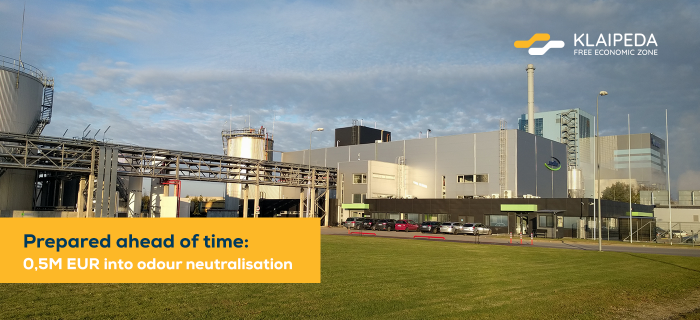News & Events
Watch our activity in one place
Mestilla Has Invested 0.5M EUR into Odour Removal Solutions

Starting with January 1st, 2024, all Lithuanian business entities will have to ensure that the odours caused by their activities will not exceed five odour units per cubic metre of air (ouE/m³) in residential environments. This measure is aimed at improving the living environment for people who live near industrial objects. Mestilla, which manufactures biodiesel from rapeseeds, spent five years looking for technologies, which would sufficiently stop undesirable odours, Verslo Žinios business daily reports.
“The new odour concentration guidelines will become a challenge for some businesses in the future, so they should start preparing ahead of the time. We know from experience that the search for a technological solution can take years and investments have to be planned ahead,” says Margarita Saulyte, the Production Director for Mestilla, a biodiesel plant in Klaipeda.
The biggest problem for businesses, according to the Director, is that there is no single odour reduction solution that would fit all situations. Each manufacturing process is unique and even specialists cannot conclusively predict the effect different solutions are going to have.
Throughout the first five years of operation, the Mestilla plant operating out of Klaipeda tried three different technologies: an odour removal reagent from Belgium, a German air cleaning scrubber, and, finally, a Swedish ozonization system.
“Our manufacturing process is very specific, we only use natural plant-based materials, so the odour is not dangerous to human health. On the other hand, the odour becomes very concentrated during the course of manufacturing, so we were looking for a solution, which would neutralize the odour instead of masking it,” the Mestilla Production Director is quoted to be saying in a press release.
Mestilla has reached the five ouE/m³ mark, which will be the maximum odour concentration allowed in Lithuania in 2024, back in 2011, after installing the German air cleaning machine. However, it was decided to look for even better technologies, which could possibly completely minimize the odour. The company found its solution when it set up an additional odour removal measure from Sweden, an ozonization system, which treats the air resulting from the manufacturing process with air. The odour distribution modeling tests carried out in 2016 and 2018 showed that the odour concentration 250 metres away from the factory is 1.8 ouE/m³, while the concentration around the closest residential spaces is only 1.2 ouE/m³, which is almost seven times less than the current hygiene requirement set by the Lithuanian Ministry of Health.
M. Salyte points out that businesses will have to live with the fact that it is impossible to reduce manufacturing-related odours to zero. At least for now. There is simply no technology capable of this feat.
“Our current result was reached by using two technologies together. It could be said that Mestilla is still on the road of discovery. We are always looking at and for new solutions that are being used worldwide. Until the perfect technology is created, it is very important for businesses to be open to local communities, listen to their concerns, show them their manufacturing processes, and explain how their technologies work,” the Production Director said, speaking on the importance of effective communication with the nearby residents.
Mestilla invested half a million EUR, so M. Salyte advises the companies that yet have to prepare for the new requirements set to come into effect in 2024 to allow for extra spending in their budgets in advance.
“Odour removal technology is not cheap. Additionally, you have to incorporate it into your manufacturing processes, which only makes it even more expensive. Operating costs will also become a new line in the budget reports,” calculates the Production Director from Mestilla.
Currently, the maximum odour concentration allowed in Lithuania is 8 ouE/m³. At first, the Ministry of Health was looking to tighten this restriction to 2 ouE/m³. There were also discussions about alternatives, like differentiating the acceptable norms in cities and rural environments, requiring 3 and 5 ouE/m³ respectively; however, in the end, the government made the decision to adopt the same requirements found in neighboring Latvia and Estonia right now.
The limit for odour concentration is measured no farther than 40 meters from a residential building or public buildings like hotels, kindergartens, schools, healthcare institutions.
